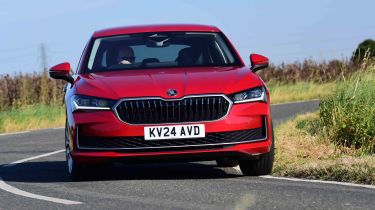Skoda Superb - Engines, performance and drive
More powerful engines suit the Skoda Superb, which excels at providing a comfortable driving experience - if not an exciting one

The Skoda Superb is not an exciting car to drive, but it is comfortable, refined and ultimately very relaxing. The steering isn’t completely weightless, but it remains light enough to make manoeuvring this 4.9-metre family car easy.
Numerous driver assistance systems make life even easier, with the adaptive cruise control maintaining a safe distance from the car on the motorway, and also using data from the sat-nav to anticipate bends, junctions and roundabouts. It also utilises traffic sign recognition and can slow down or accelerate the car according to the speed limit. There’s lane keep assist to make sure you don’t stray out of your lane, too.
You can tailor how the Superb rides with the optional ‘Dynamic Chassis Control Plus’ (DCC Plus) on SE L trim cars (standard on Laurin & Klement), which includes adaptive dampers that you can adjust the settings of via the central touchscreen using the same sliding scale as on many high-end VWs. It goes from a superbly supple and refined ride in its comfort setting, to something much tighter in sport mode, which is helpful to keep body movements under control at higher speeds on twisty roads and motorways.
It isn’t a necessary option, though, because we found that the standard suspension is, on the whole, very well judged. Aside from a slight fidget over rougher surfaces, it softens the impacts of potholes to give a cushy ride, yet it remains taut enough to allow the car to feel stable at high speeds and stay level during fast corners. It suits the Superb well, and complements the excellent road noise suppression and substantial reduction in wind noise compared with the previous Superb.
|
Model |
Power |
0-62mph |
Top speed |
|
Superb Hatch 1.5 TSI 150 e-Tec MHEV DSG |
148bhp |
9.3 seconds |
139mph |
|
Superb Hatch 2.0 TSI 265 4x4 petrol DSG |
262bhp |
5.6 seconds |
155mph |
|
Superb Hatch 2.0 TDI 150 diesel DSG |
148bhp |
9.2 seconds |
139mph |
|
Superb Estate 1.5 204 iV PHEV DSG |
201bhp |
8.1 seconds |
136mph |
Engines, 0-62mph acceleration and top speed
The slowest Skoda Superb is the entry-level 148bhp 1.5-litre four-cylinder petrol, with a 0-62mph time of 9.3 seconds and a top speed of 139mph. This engine does come with mild-hybrid technology, so while acceleration is more leisurely than on other models in the range, this engine is smooth and has a slick start-stop system that works well when driving in town. The engine produces a rather unpleasant drone during hard acceleration and it tends to hang on to the lower gears a bit too long while accelerating, but it fades into the background when you lift off once up to speed.
Next is the 148bhp 2.0 TDI, with its extra torque over the 1.5 eTSI petrol helping shave a little off the 0-62mph time, which drops to 9.2 seconds. It’s not the most refined diesel engine at low speeds, but it is a responsive engine that pairs well with the standard seven-speed DSG automatic. Opt for the more potent 190bhp version, and its additional power and traction advantage of four-wheel drive cuts the acceleration time to 7.5 seconds, and goes on to a top speed of 147mph.
The quickest Superb is the 261bhp 2.0 TSI, which has a 5.6-second 0-62mph sprint and a 155mph top speed. Those aren’t shabby figures, but Skoda is preparing a high-performance Superb vRS for the first time, which will take on hotter family saloons and estate cars from the likes of BMW, Mercedes and Audi. Exciting stuff.
It’s worth noting that only the Skoda Superb Estate is available as a PHEV (plug-in hybrid electric vehicle). This version uses a 1.5-litre petrol combined with an electric motor to provide 201bhp and an 8.1-second 0-62mph time and 136mph acceleration time.








